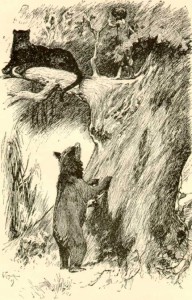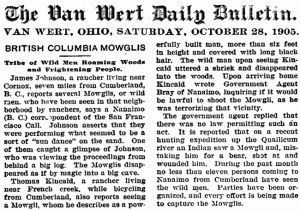
November 3, 2010
Early Sasquatch Were Called Mowglis
by Loren Coleman, Bigfoot!: The True Story of Apes in America and The Field Guide to Bigfoot and Other Mystery Primates (with Patrick Huyghe).

At the turn of the 19th and 20th centuries, and shortly afterward, the popularity of the word “Mowgli” was so great that reports of what we today call “Bigfoot” and “Sasquatch” appear to have been mentioned using that term. Such a process, the use of the name of a strange, rural, wild, uncivilized human-like being from fiction being employed to describe nonfiction sightings of hairy hominoids, occurred more than once.
The Mowgil situation is very similar to the circumstances that resulted due to the use of the “Yahoos” from Jonathan Swift’s Gulliver’s Travels (1726, amended 1735) to describe the hairy unknown hominoids reported from Australia. Today those Australian “Yahoos” are more frequently called “Yowies.” Others have written of Daniel Boone’s liking for Gulliver’s Travels, and how “Yahoos” from that book could have been a term for Eastern Bigfoot in early America.
Mowgli (pronounced /ˈmaʊɡli/) is a fictional character from India who originally appeared in Rudyard Kipling’s short story “In the Rukh” (collected in Many Inventions, 1893) and then went on to become the most prominent and memorable character in his fantasies, The Jungle Book and The Second Jungle Book (1894–1895), which also featured stories about other characters.
The Mowgli stories, including In the Rukh, were first collected in chronological order in one volume as The Works of Rudyard Kipling Volume VII: The Jungle Book (1907) (Volume VIII of this series contained the non-Mowgli stories from the Jungle Books), and subsequently in All the Mowgli Stories (1933).
Mowgli has been cited as a major influence on Edgar Rice Burroughs‘ character Tarzan. Mowgli was also an influence of a number of other “wild boy” characters; see Feral Children in Mythology and Fiction.
In the stories, the name Mowgli is said to mean “frog.” Kipling made up the name, and it “does not mean ‘frog’ in any language other than the language of the forest.” Kipling stated that the first syllable of “Mowgli” should rhyme with “cow” and is pronounced this way in Britain, while in America it is almost always pronounced to rhyme with “go.”
Below are two newspaper stories of the reports of “Mowglis” in British Columbia in 1905. (One must remember, before Walt Disney Studios made The Jungle Book into a movie, the Freemason Kipling placed various levels of symbolize in his rough and ready story of a wild boy among the wild beasts.)


British Columbia Mowglis
Tribe of Wild Men Roaming Woods and Frightening People
October 28, 1905
James Johnson, a rancher living near Comox, seven miles from Cumberland, B.C., reports several Mowglis, or wild men, who have been seen in that neighborhood by ranchers, says a Nanaimo (B.C.) correspondent of the San Francisco Call. Johnson asserts that they were performing what seemed to be a sort of “sun dance” on the sand. One of them caught a glimpse of Johnson who was viewing the proceedings from behind a big log. The Mowglis disappeared as if by magic into a big cave.
Thomas Kincaid, a rancher living near French creek, while bicycling from Cumberland, also reports seeing a Mowgli, who he describes as powerfully built man, more than six feet in height and covered with long black hair. The wild man upon seeing Kincaid uttered a shriek and disappeared into the woods. Upon arriving home Kincaid wrote Government Agent Bray of Nanaimo, inquiring if it would be lawful to shoot the Mowgli, as he was terrorizing that vicinity.
The government agent replied that was no law permitting such an act. It is reported that on a recent hunting expedition up the Qualicum River an Indian saw a Mowgli and, mistaking him for a bear, shot at and wounded him. During the past month no less than eleven persons coming to Nanaimo from Cumberland have seen the wild men. Parties have been organized, and every effort is being made to capture the Mowglis.
+++
Boston Daily Globe
December 31, 1905
HAIRY GIANT ROAMS WOODS.
Island of Valdez Sound Terrorized by a “Mowgli” in Real Life.
The residents of Valdez Island, near Comox, B.C., have been terrorized of late by visits from Vancouver island’s now famous “Mowgli.”
A rancher from Valdez island reported that the wild man of Vancouver island is at present on Valdez, and by the description of the creature which he solemnly asserts he saw, including the corroboration of half a dozen others, the “Mowgli” is undoubtedly the same as seen near Horne lake two months ago.
A family named Pitcock, residing on Valdez, last week was frightened one night about 10 o’clock while sitting at supper by seeing a ghastly face looking through the window into the room.
The face was covered with long black coarse hair, only a small portion of the skin being visible. Directly the creature saw he was noticed[,] he uttered a diabolical scream, which was heard by ranchers nearly a mile away, and vanished.
A number of young farmers with rifles searched the vicinity next day without success. Large prints of feet upon the soft earth of a flower bed under the window was [sic] the only sign of the monster, who, according to those who have seen him, is nearly seven feet tall.
Twice during the next night the family heard a scream similar to that uttered by the wild man. All that day a careful watch was kept, but there were no signs of the “Mowgli,” although there were a number of footprints corresponding with those seen before, which were found along the creek that passed the Peacock household.
The next night a dozen well-armed men concealed themselves near a stack of hay where the footprints of the “Mowgli” were traceable. About 10:30 p.m. horrible yells were heard in the direction of the creek and after waiting for an hour some of the posse determined to go in that direction.
They had gone up the stream about half a mile when the light of a lantern carried by the “Mowgli” came into view. Hiding behind a tree the posse had
a splendid chance to view this denizen of the woods.
They describe him as very tall and powerfully built and with the exception of a few rags hanging from a belt at his waist he was entirely naked. His body was covered with long black hair and the face was identified was identified as that seen at the Pitcock home the evening previous.
The men, after recovering from their fright, broke from cover and one raised his rifle, but before he could find range the “Mowgli,” who had by this time discovered the farmers, threw himself into the icy waters and swam for the other side of the creek.
Nothing more has been seen of him around the Pitcock residence, although two half-breeds of Alert Bay claim to have seen the same man a few days after. – Seattle Times.
+++
Thanks to Jerome Clark and Scott McClean for the finding and dissemination of these original articles to their fellow researchers.
About Loren Coleman
Loren Coleman is one of the world’s leading cryptozoologists, some say “the” leading living cryptozoologist. Certainly, he is acknowledged as the current living American researcher and writer who has most popularized cryptozoology in the late 20th and early 21st centuries.
Starting his fieldwork and investigations in 1960, after traveling and trekking extensively in pursuit of cryptozoological mysteries, Coleman began writing to share his experiences in 1969. An honorary member of Ivan T. Sanderson’s Society for the Investigation of the Unexplained in the 1970s, Coleman has been bestowed with similar honorary memberships of the North Idaho College Cryptozoology Club in 1983, and in subsequent years, that of the British Columbia Scientific Cryptozoology Club, CryptoSafari International, and other international organizations. He was also a Life Member and Benefactor of the International Society of Cryptozoology (now-defunct).
Loren Coleman’s daily blog, as a member of the Cryptomundo Team, served as an ongoing avenue of communication for the ever-growing body of cryptozoo news from 2005 through 2013. He returned as an infrequent contributor beginning Halloween week of 2015.
Coleman is the founder in 2003, and current director of the International Cryptozoology Museum in Portland, Maine.
Filed under Bigfoot, Books, Cryptofiction, Cryptomundo Exclusive, CryptoZoo News, Eyewitness Accounts, Folklore, Sasquatch